
Jonathan Ochshorn
First published as: Ochshorn, Jonathan, "Disembodied Technology and Design," Body, Technology and Design, pp.16-18 (© 1993 ACSA).
INTRODUCTION
The subset of the field of technology that deals with the transformation and utilization of materials to create works of architecture is itself in the midst of a profound transformation. From a conceptual model in which materials were understood to be the tangible, knowable and discrete products of nature and industry such as wood, stone, brick, steel and glass, and in which the technical hurdles to be overcome could be understood simply in terms of structure and enclosure, we have entered an era in which both the materials themselves as well as the technical problems to be solved have become relatively insubstantial and intangible. Specifically the problems of support (structure) and enclosure have been redefined as problems of creep and deflection, heat loss, air infiltration, permeance to vapor, condensation and exposure of the building interstices to water. At the same time, the traditional materials of construction are being transformed into products and systems whose material content is often obscure.
This is more than a mere elaboration of the original categories and represents a qualitative change in emphasis. Where the earlier notions of support and enclosure could sustain an enormous body of theory concerning the relationship of form to its material basis, the problems of infiltration, heat loss and so on have generated primarily technical responses; what has yet to be fully acknowledged is the inversion or redefinition of the conceptual underpinnings of building construction and detailing that these new technologies imply.
TECTONICS AND MODERN TECHNOLOGY
The difficulty lies in the relatively intangible and abstract qualities of what have become the central technical issues in building. It is instructive to begin with a quote from Ruskin, whose rejection of "iron" as an acceptable material of structure anticipates much of the discussion occurring later in the 19th and 20th century concerning materials and their appropriate use:
The definition of the art of architecture… is independent of its materials: nevertheless, that art having been, up to the beginning of the present century, practised for the most part in clay, stone, or wood, it has resulted that the sense of proportion and the laws of structure have been based, the one altogether, the other in great part, on the necessities consequent on the employment of those materials; and that the entire or principal employment of metallic framework would, therefore, be generally felt as a departure from the first principles of the art… it will be felt right to retain as far as may be, even in periods of more advanced science, the materials and principles of earlier ages.1
Ruskin's entire argument is to invoke the familiar – architecture's "historical use" – against the new. But what is interesting is the disclaimer he inserts, reluctantly acknowledging that the "familiar" is itself a volatile and culturally-based artifact: he writes, "Abstractly there appears no reason why iron should not be used as well as wood; and the time is probably near when a new system of architectural laws will be developed, adapted entirely to metallic construction."2
Ruskin's use of the term "architectural laws" rather than "constructional" or "structural laws" is significant: for him, as for many of his contemporaries, architectural forms were considered to possess important cultural and aesthetic attributes that grew out of, yet transcended, their technical or functional basis. This "tectonic" appreciation of material and function was described more explicitly by Karl Bötticher in a book published three years later. Its motto, in which the Hegelian view of material reality is clearly reflected, summarized the concept as follows: "The form of the body is the mirror of its essence! Master it and the seal of the riddle is broken."3
This idea that material and function contain within themselves the expressive potential to reveal their true nature, and that the "artist must be brought in not for his a priori personal sensibility but for his ability to give expression to what was objective in a situation..."4 still underlies much of the discussion of architectural technology.5 The problem with this concept is not that architectural forms ought to be, or even can be, derived from some objective statement of material properties and functional objectives; rather it is the mystification of the processes and results of human design by the attribution of some kind of intrinsic formal logic to the products themselves. In other words, the problem is not with the results of the design process, but with the ways in which the reconciliation of form and technology is explained. Yet even accepting the tectonic concept as a short-hand device for appreciating the connections between form, function, material and technology, two conditions must still be met: first, the significant technical considerations that inform works of architecture must be identified and understood; and, secondly, the material conditions encountered must be related to a broader cultural/aesthetic agenda. On both of these counts, theoretical stances that continue to apply this tectonic model to the conditions associated with modern construction materials and methods are on shaky ground.
MATERIALS AND FUNCTION
In a recent book by the late Ronald Brand6, criteria for architectural detailing are established which provide a useful framework for examining these issues. Specifically, Brand suggests eight rules upon which the design of building envelopes should be based. Rather than starting with problems of structural framing, cladding or the integration of various systems into a coherent whole, Brand begins, with Rule No. 1, by insisting that the building be enclosed by a continuous air barrier. The implications are quite startling. For one thing, an air barrier is something so abstract that it cannot be immediately identified as either a material or a product.7 Secondly, compared to the traditional elements of structure and enclosure, it contains no great intrinsic rigidity or mass. It seems insubstantial by comparison–almost an afterthought squeezed between cladding and structure, but hardly capable of upsetting the traditional expressive dominance of brick, stone, concrete, steel or glass. Yet these conventional materials and the constructional techniques associated with their use do not figure in the logical overview presented by Brand.
Rule No. 2 again inverts the conventional wisdom, this time with respect to structure: "Provide continuous support for the air barrier against wind loads." Rather than assuming a primary or determining role, structure is here made explicitly subservient to the requirements of the air barrier. Similarly Rule No. 3 turns the issue of structural movement into the problem of insuring the integrity of the air barrier ("Ensure that the air barrier is flexible at joints where movement may occur.").
Rules Nos. 4 and 5 introduce the notion of insulation — an equally insubstantial material presence — "to keep the air barrier warm and to conserve energy..." Rule No. 6 relegates the whole issue of cladding to a purely subservient role: "Protect the insulation with a rainscreen/sunscreen supported out from the structure in a way that does not penetrate the insulation with excessive heat bridges." Finally, Rule Nos. 7 and 8 define the most intangible element of all: a "space for drainage and construction clearances between the rainscreen and the insulation."8
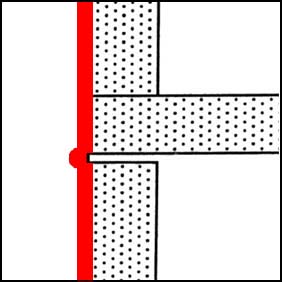
(b)
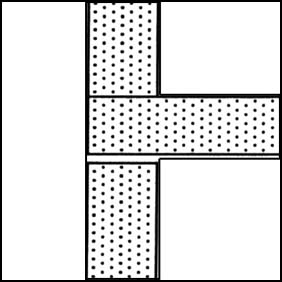
(a)
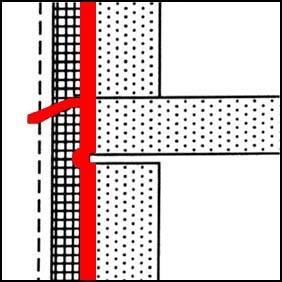
(d)
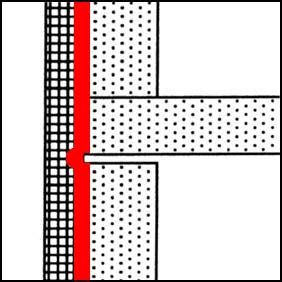
(c)
Figure 1. Brand's principles of detailing: a) assemble basic structure; b) add air barrier (shown here in red, but as heavy black line in published essay); c) insulate tight to air barrier; d) protect air barrier with rainscreen/sunscreen. (Based on the diagrams in Brand, Architectural Details..., drawn by the author)
Taken all together, these rules represent a radical and profound change in emphasis regarding the essential components of building construction. Structure and cladding, whose expression and material presence have formed the cornerstone of so much architectural theory and practice, are now presented as subordinate elements whose continued existence is conditioned upon their utility in supporting and protecting the building's air barrier and insulation. To make the point even clearer, Brand presents a series of four schematic diagrams in which the primacy of the air barrier—pictured throughout the text as a continuous red line in contrast to the black and white rendering of everything else—is unequivocal (Fig. 1).
EXPRESSIVE INTENTIONS
In the mid-19th century Ruskin speculated about the inevitable rise of "architectural laws ... adapted entirely to metallic construction;" whether he would have been as open-minded regarding the tectonic appreciation of polymer-modified asphaltic membranes and glass fiber insulation is less clear. For the most part, proponents of the expression of materials have tended to criticize the implications of this new technology in much the same way that Ruskin reacted to the use of iron.
In fact, the solution of technical problems is often dismissed as being secondary in importance when measured against the expressive or tactile qualities that might result. Although differing in their pretensions to theoretical rigor, Frampton's critique of "optimized technology" and the "scenographic" (architecture derives its "autonomy" from "the revealed ligaments of the construction and in the way in which the syntactical form of the structure explicitly resists the action of gravity" 9) and Rasmussen's attack on the intermixing of granite and concrete in the sidewalks of Denmark ("... you can almost feel how unpleasant it is right through the soles of your shoes..." 10) are both manifestations of this sentiment.
On the other hand, a theoretical framework that does not rely upon attribution of intrinsic architectural or moral qualities to materials would be likely to accommodate more dispassionately the implications of this technology. Michael Graves on gypsum board ("It's a surface that gains some identification beyond the junk it's made of, by virtue of its color, its texture, its placement." 11) may serve as an example.
There are, of course, some problems with Brand's approach to constructional efficiency. On the one hand, that part of the rationale driven by considerations of building envelope failure is consistent, well documented and quite convincing. On the other hand, the economic pressure to reduce energy consumption by effectively sealing buildings has created the potential for enormous problems of indoor air quality. Brand devotes less than one paragraph in dismissing this issue, extolling the "sophisticated and expensive mechanical systems to condition the air used in buildings..." that can remove not only "particulate matter ... but pathogens and even some unwanted molecules."12
Brand's discussion of the formal implications of his approach is equally terse, but consistent with his stated intention to provide only "construction details based on building science."13 Under the heading "Aesthetic Considerations" he writes: "Resolving the architect's wishes for meaning, scale, order, proportion, etc. with all the other issues that have been mentioned is always very difficult."14 Period.
Finally, it should be emphasized that Brand is talking only about buildings "in climates where cold winters make insulation necessary."15 The entire argument, whose implications for the expression of materials and technical function are so profound, does not apply to works of architecture in milder climates (although the problem of wind-driven rain has generated similarly layered "rain-screen" strategies in non-insulated buildings). This in itself suggests a paradoxical state of affairs in which the technically-significant elements of building construction become less substantial precisely where the environmental constraints are most severe; and in which the tradition of understanding architectural form in relation to the "materials and principles of earlier ages" may survive only on a regional (climatic) basis.
CONCLUSION
Brand's decision to render his air barrier as a continuous and abstract red line throughout the text points out his insistence on redefining the primary versus contingent aspects of building construction. The red line invariably bisects the construction, since the air barrier typically must be protected or screened from both the outside and the inside. This, in turn, reinforces the fragmentation of the wall, a tendency whose origins can be traced back several centuries to the earliest attempts to block the migration of water through masonry walls.16
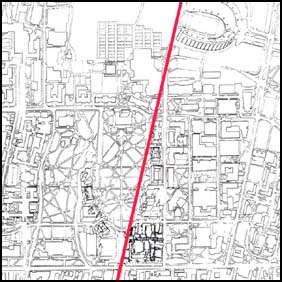
(b)
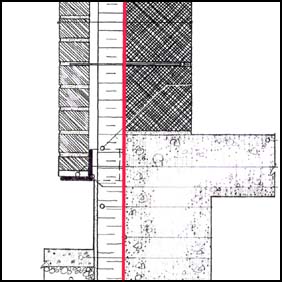
(a)
Figure 2. The abstract line has the effect of subverting the conventional wisdom regarding the deployment of architectural or technological elements: a) wall section (from Brand, Architectural Details..., p.28) ; b) OSU campus plan as interpreted by Eisenman (from Progressive Architecture, October, 1989, p..69).
This idea of fragmentation, while only recently manifested as a technological imperative, has appeared as a cultural, and therefore architectural, issue since at least the Renaissance.17 It is therefore not wholly coincidental that Brand's ubiquitous red line, "tracing the line of airtightness"18 within the overall enclosure system, should have a parallel in the red line drawn by Peter Eisenman on the OSU campus plan for the Wexner Center competition, a work of architecture in which "strategies of dislocation and interruption: fragmentation and doubling"19 are explored. In both cases, the abstract line has the effect of subverting the conventional wisdom regarding the deployment of architectural or technological elements (Fig. 2).
Yet in spite of formal similarities, the two examples refer to distinct and potentially independent methodologies – one concerned with architectural form, style and so forth; the other with building science. And just as Wexner's building technology (steel frame and concrete floors, curtainwalls, brick, limestone and sandstone cladding, drywall, etc.) cannot be invoked to explain Eisenman's stylistic idiosyncrasies, any attempt to extrapolate Brand's eight rules of detailing into a formal aesthetic agenda would similarly prove pointless. In the long run though, the relentless logic of Brand's radical inversion of the primacy of structure, mass, rigidity and all the other terms in which the traditional qualities of materials are expressed, may have a more permanently dislocating effect upon architectural theory and practice than the more explicit attempts to change the "style and significance of… the look of architecture" independent of its technological basis.20
NOTES
1 Ruskin, John, The Seven Lamps of Architecture, Noonday Press (New York, NY), 1974, p.43.
2 Ibid., pp.43-44, emphasis added.
3 For a discussion of the concept of Tektonik in the writings of Bötticher and Semper, see Anderson, Stanford, "Modern Architecture and Industry: Peter Behrens, the AEG, and Industrial Design," Oppositions, Summer 1980, pp. 82-88; the quote from Bötticher relating form to essence is translated by Anderson in the same article—see note 16, p.83.
4 Ibid., p.86.
5 The idea of an "essence" or "nature" of materials is often used to explain or critique architectural form. For two examples from recent books on architectural technology, see: Patterson, Terry, Construction Materials For Architects and Designers, Prentice Hall (New Jersey), 1990, p.xi ("Acknowledging the nature of building materials...," or "the architecture ... has a general sense of harmony with the essence of its materials."); and Guise, David, Design and Technology in Architecture, Van Nostrand Reinhold (New York, NY), 1991, p. 2 ("The Crypt de la Colonia Guell ... used the inherent nature of its materials..."). Emphasis added.
6 Brand, Ronald, Architectural Details for Insulated Buildings, Van Nostrand Reinhold (New York, NY), 1990; a summary of the principles appears in Brand, "An Approach to the Design of Insulated Building Envelopes," Symposium on Architecture and ACSA Technology Conference '89.
7 See, for example, Rousseau, Madeline Z., "Air Barriers and Vapor Barriers: Are They of Any Use in Low-Slope Roofs?," Progressive Architecture, August, 1990: "An air barrier is not a material; you cannot buy one."
8 These rules appear in Brand, op. cit., p.5 (emphasis added in final quote).
9 Frampton, Kenneth, "Towards a Critical Regionalism," The Anti-Aesthetic: Essays on Postmodern Culture, Hal Foster, ed., Bay Press (Seattle) 1983, p.27.
10 Rasmussen, Steen Eiler, Experiencing Architecture, MIT Press (Cambridge, MA) 1962, p.25.
11 Michael Graves is quoted in "Conversations with Graves," Progressive Architecture, February, 1983, p.112.
12 Brand, op. cit., p.162.
13 Ibid., p.ix.
14 Ibid., p.207.
15 Ibid., p.4.
16 Ochshorn, Jonathan, "On the Disappearance of Monolithic Walls: Meditations on a Brick," Making Environments: Technology and Design, Proceedings of the 10th Annual ACSA Technology Conference, The ACSA Press (Washington, DC) 1992.
17 See, for example, Jarzombek, Mark, On Leon Baptista Alberti, The MIT Press (Cambridge, MA) 1989, pp.88-89; summarizing Alberti's thoughts on this matter in De re aedificatoria, Jarzombek writes: "Eventually, however society developed into such complexity that 'the various kinds of buildings have become almost infinite.' ... The momentum away from 'nature' cannot be arrested, but the resulting fragmentation could be controlled by a continuous and conscious ordering process."
18 Brand, op. cit., p.5.
19 Taylor, Mark, "Eisenman's Coup," Progressive Architecture, October, 1989, p.89.
20 Eisenman, Peter, "Architecture as a Second Language" Restructuring Architectural Theory, Diani and Ingraham, eds., Northwestern University Press (Evanston, Illinois) 1989, p.71.
First posted 14 April, 2006; last updated 22 January, 2008 [minor re-formatting]